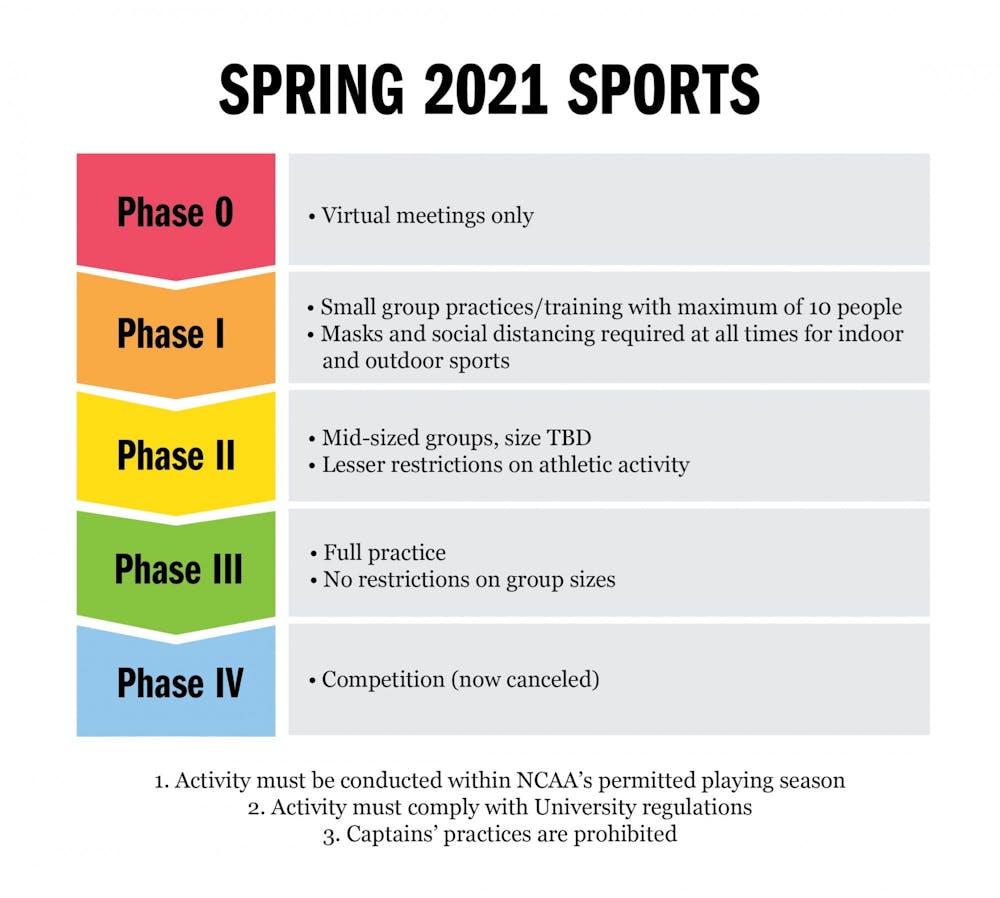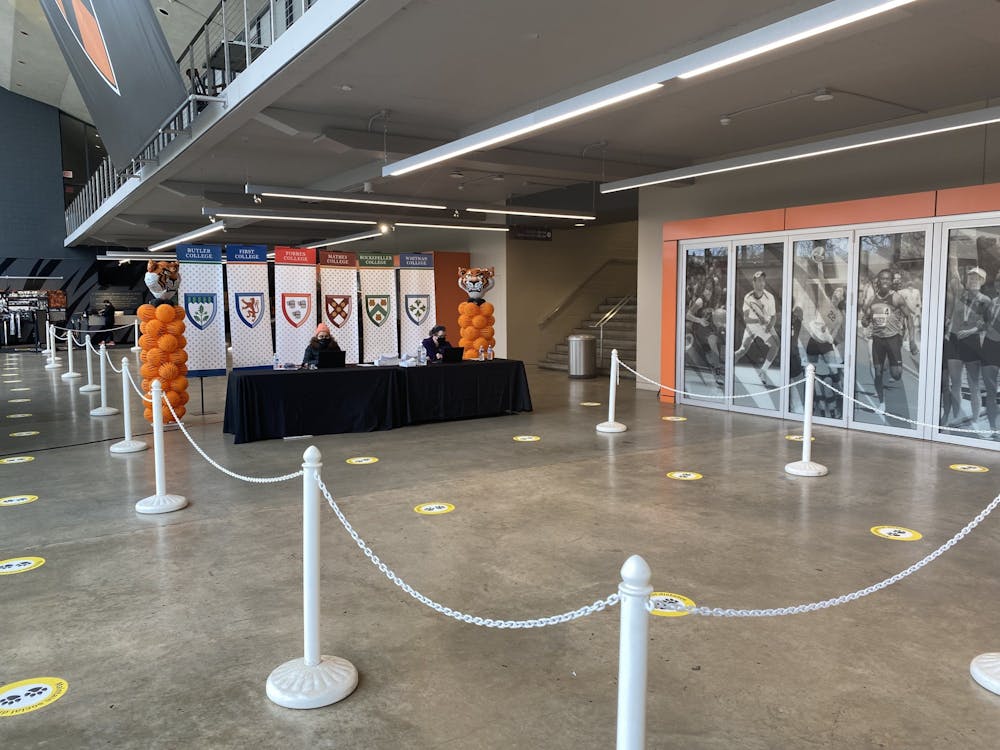Feb. 1 marked the University’s first day of classes, as well as the start of Phase I of the Ivy League’s plan for resuming athletics. But with the recent decision to suspend league competitions for the entire spring season, student-athletes may now be limited to practices for the rest of the semester.
Phased-In Plan for Spring Athletic Activity
In order to make training possible for athletes, the University is following a strict phased-in plan that establishes restrictions and social-distancing regulations during practice. The multi-tiered plan is consistent with the phased-in approach that other Ivy League institutions adopted in the fall 2020 term for their in-person semester — specifically those of Brown, Cornell, Dartmouth, Harvard, and Yale.
The League’s original four-phase plan outlined a progression from a completely virtual Phase 0 to a full 12 hours of weekly physical activity in Phase III. Yale spent a majority of their first semester in Phase 0 after the emergence of several COVID-19 clusters and an outbreak on the men’s ice hockey team.
At Princeton, Phase 0 for the spring semester took place during the move-in and quarantine period, when students began returning to campus in staggered cohorts. This phase permitted virtual team meetings for up to six hours each week. In-person gatherings were prohibited during this time, and no team practices were conducted.

Visual representation of the phased-in athletic approach implemented by the Ivy League.
Ashley Chung / The Daily Princetonian
Phase I, the current phase, allows for small-group activities of up to 10 people. While abiding by NCAA rules, teams are allowed up to 12 hours of in-person physical activity and eight hours of team meetings per week, totaling a maximum of 20 hours each week. Practices and meetings for both indoor and outdoor sports may not exceed four hours per day and must adhere to University-wide mandates, such as wearing masks and social distancing. There is also an NCAA mandate that one day a week be completely off from athletic activity.
“We are following all University and athletic department guidelines by creating small training groups and using the weight room with social distancing as our guide,” Brad Hunt, head coach of the women’s cross country team, said. “The most noticeable change is staggering the start of practice to ensure smaller training groups.”

Phase II is similar to Phase I but permits some additional activities. Practices and in-person meetings will allow for a greater number of people, giving coaches the opportunity to have more athletes in their practice sessions. The maximum number of people allowed per group in Phase II has yet to be announced by the University.
Phase III will mark the beginning of full practices. Like Phases I and II, teams are limited to a maximum of 20 hours per week and four hours per day of athletic activity, though there is no longer a size limit on practice groups.
“We hope that if the number of cases remain low, we may get to proceed in phases and enjoy even more opportunities,” Sam Shweisky, head coach of the men’s volleyball team, said.
While Phase IV was originally slated as a full return to competition, the recent announcement by the Ivy League states limited local competition after March 1 is possible for outdoor sports if public health conditions “improve sufficiently.”

The State of Athletic Facilities
The Athletics Department has undergone major changes to prioritize the safety of students, coaches, and staff. All of Princeton’s athletic facilities — including Dillon Gymnasium and Jadwin Gymnasium — have been re-configured to allow for social distancing and adhere to University health protocols.
As it has done every winter for the past four years, the University erected a “bubble” over the Powers Field for Princeton's varsity teams, as well as club and intramural sports, to use over the next several weeks. The bubble is a climate-controlled, full-field indoor facility that was funded in 2017 by an anonymous $3.5 million dollar gift.
The bubble is open for recreation four hours per day, Monday through Saturday, with scheduled team practices taking place throughout the remaining time. Squat racks, originally in the stadium weight room, have been moved to the field to allow for socially-distant weightlifting. The weight room now houses the fueling station, which provides athletes snacks such as energy and protein bars to help ensure proper nutrition.

The “bubble” over Powers Field now houses squat racks from the varsity weight room.
Howard Wang / The Daily Princetonian
Though COVID-19 policies strictly prohibit captains’ practices (team training conducted without a coach present), the Athletics Department emphasizes that facilities may be used for voluntary activities per campus policies. This means that student-athletes have access to facilities including Jadwin Gym, Dillon Gym, Hobey Baker Rink, DeNunzio Pool, Princeton Stadium, Shea Rowing Center, as well as other fields and courts throughout campus to train on their own time while adhering to the specific guidelines outlined by the athletics department.
Each training facility abides by strict guidelines to decrease the risk of COVID-19 transmission. These guidelines include having all visitors sanitize their hands before entering and exiting the facilities, spraying down equipment with disinfectant before and after use, and ensuring that all student-athletes are symptom-free by providing confirmation from the online symptom checker.
Locker rooms and team meeting rooms remain closed, but Athletic Medicine of the University Health Services will continue to offer services to student-athletes by appointment for emergency and acute injuries only. There are three trainers on staff at all times and the athletic training room remains open six days a week, Monday through Saturday.
Stay Positive, Test Negative
Tigers who are exposed to COVID-19 but do not test positive must enter Phase 0 of a “graded” return-to-play timeline (distinct from the broader phased plan) and quarantine for seven to ten days. During this period, student-athletes will be allowed up to one hour of solitary outdoor fitness. Risk from exposure will be judged on a case-by-case basis by a physician. Athletes may only progress in the timeline and begin conditioning under the guidance of coaches and athletic trainers if they receive “Global and Community health clearance.” The time period for these phases are individualized and athletes may only progress to subsequent phases if they are symptom-free.
“All of the protocols put in place have been well-thought out and well-implemented with safety as the number one priority,” Shweisky said.
If student athletes are diagnosed with COVID-19, there is a different return-to-play process in place. Phase 0 of the process is a mandatory 10-day isolation period. Athletes must rest during this time and are prohibited from any form of exercise. In order to progress, athletes must be symptom-free for at least 24 hours and receive medical clearance from a physician due to reports of cardiac complications after COVID-19 infection, such as myocarditis.
“One of our team physicians will perform an evaluation after your period of self-isolation to determine if further cardiac testing is required,” Sophia Gonzalez, a physical therapist for University Health Services, wrote in an email to all student-athletes.
After completing the isolation period, athletes may progress to Phase I, which consists of a seven-day period with no exercise, except for walks around campus and light stretching. After exhibiting no symptoms for seven days, athletes may enter Phase II, which is a two-day period in which only forms of exercise that do not raise their heart rate beyond 50 percent of their maximum are allowed. Again, athletes must remain symptom-free to progress to the next phase.
Subsequent phases allow athletes to increase exercise intensity and duration to prepare them for a complete return to training. Phases III and IV allow for jogs and bodyweight circuits for 30-45 minutes, and Phase V permits athletes to return to strength training with their team in the bubble. Phase VI lifts all exercise restrictions and athletes may return to normal practice. They will be supervised by trainers and coaches along the way to ensure that they are conditioning properly in order to return to practice safely.
Despite the challenges COVID-19 has posed this semester, Hunt said he remains positive and excited for the future.
“We are focused on the aspects we can control in our daily approach to training,” Hunt said. “The two most controllable aspects each and every day is our attitude and effort. We fully expect to be ready for any and every opportunity ahead, and we look forward to representing Princeton University in the competitive arena.”








